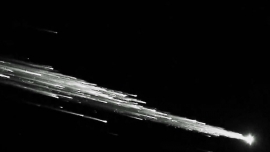"If I think about the future of cinema as art, I shiver" (Y. Ozu, 1959)
Meteors (Gürcan Keltek)
Monday, 27 November 2017 10:20Giona A. Nazzaro
The thing itself
Gürcan Keltek’s first feature-length film is an astonishing survey of the possibilities still open and available to those who are working inside the boundaries of cinema. Tackling images and cinema as tools and means to further inquire about the set of rules that film-making is still dealing with, Keltek creates a tremendous visual and sensorial experience that has no equals in contemporary cinema today (with the only exception of Ala Eddine Slim’s work). His visual approach, already clearly refined and fully fleshed out in Fazlamesai (Overtime) – his first short film – evolves further on in Meteorlar (Meteors). Structured in what appears to be a narrative loosely tied by several chapters, there is a deeply resonant web of cosmic audio-visual fabrications. It deals obviously with the Kurdish identity and war, but the film also manages to evoke the so-called documentary elements of a broader context. The film begins and ends with a moon that slowly rises in the night sky. And it is the very same moon that ends it. Inbetween, there are scenes from a mountain hunt, the Kurdish guerrilla, and violent protests against the Turkish military and police as well as the voices of children and an unbelievably breath-taking meteor shower. Thus, Keltek manages to do several things in just one film. He questions the very notions of documentary and militant and politically engaged film-making. Keltek, an extraordinarily accomplished visual film-maker, depicts not only a very specific region (the southeast of Turkey), but produces a consistent mythopoeic universe in which image and sound redefine both the notion of watching and that of the image.
Shot in an elegant, grainy, very low-defined black and white, the image seems to be always on the verge of tearing itself apart of to simply expose its pixels (and it does happen…). Keltek tests the texture of the image as the image itself were a war zone. It is as if Keltek needed to go to war against the image to try re-thinking the possibilities of how to film a war in the current context. So, the unthinkable happens: the film becomes an immense and pulsating cosmic canvas, as if Tangerine Dream where reprocessed by Aphex Twin’s deconstructing approach. This is how Keltek can call upon an entire country and its politics in a precise historical moment and in a brutally, excruciatingly exact way.
Thus, Meteors becomes Turkey itself. No longer a film “about something” but the “thing” itself. Keltek’s keen ability for filming and framing landscapes, volumes, depths, texture and the dialectics of sound and vision, reaches its peak at the sight of Nemrut’s head. Suddenly, we are no longer on the northern border of the Kurdish district but in a completely different time and place. While the grainy images never allow us to forget that we are watching someone who is working (making a film…), the sheer volume of conflicting elements allows Meteors to transcend its own limits. The film becomes a powerful rumination on mankind and the void they are living in, but also a reflection of the endless returning cycle of the seasons of war and grieving.
Out of nowhere though, two snakes dance their mating rituals. It’s a mesmerizing and disturbing image. We cannot tell the two snakes apart.
Gürcan Keltek creates a sensuous and mysterious place of cinematic (im)purity. By accepting in the fabric of his film all those elements that are usually shunned upon, he also questions the notion of economic politics in film-making. Meteors is a new territory on the maps of contemporary cinema. It’s a filmic abstraction that becomes the most accurate depiction of what can still be done with cinema today. A timely and much needed reminder of the necessity of re-thinking the overall context of contemporary filmmaking.
Meteors is already a modern-day classic. A film on which we will look back whenever we will need tools and ideas and images, whenever we need to redefine and re-orient our position.
It’s that rare and precious film.
Ultimi articoli pubblicati
- 2025-03-24 Chime/Cloud/Serpent’s Path (Kurosawa Kiyoshi)
- 2025-03-24 Abiding Nowhere (Tsai Ming-liang)
- 2025-03-24 The Box Man (Gakuryū Ishii)
- 2025-03-24 Grand Tour (Miguel Gomes)


